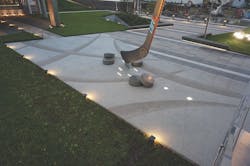‘Cool’ pavement creates ice rink aesthetic outside NHL practice facility
Created from custom-designed mixes of decorative concrete, the hardscape outside of the Boston Bruins new Warrior Ice Arena and Practice Facility is both aesthetically pleasing and sustainable. The concrete contains unique colors, aggregates, and textures, as well as treatments to reduce the urban heat island effect, to achieve the desired look, while also meeting the project’s LEED certification goals.
The project team worked with Aggregate Industries to develop the special mix using the company’s Artevia Color and Artevia Exposed decorative concrete products in white and gray, with a highly reflective coloring admixture from L.M. Scofield.
The Artevia Color concrete, with onyx black and custom gray alternating strips, was placed at street level. The Artevia Exposed concrete, with colored stones and glass, was used for the elevated courtyard.
The most unusual aspect of the hardscape is a 68-foot-high hockey stick surrounded by concrete pucks and large, sweeping patterns in the concrete to resemble skate marks on ice, at the arena’s main entrance.
